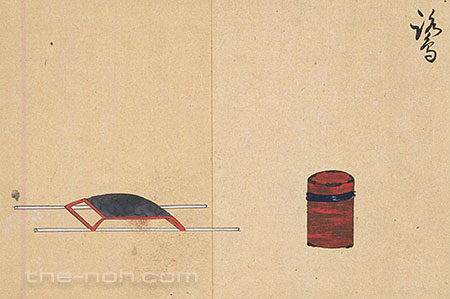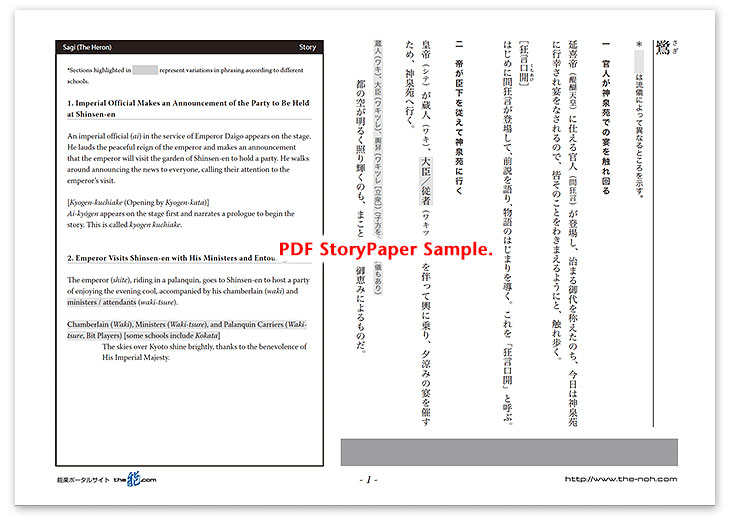
 Sagi (The Heron)
Sagi (The Heron)

![]()
These events happen on a summer day, during the era of Emperor Daigo. The emperor is hosting a party in the royal garden of Shinsen-en in Kyoto, to enjoy the evening cool. On the sandbar in the pond in the garden, a white heron is prancing around, while the evening moon, reflected on the water, looks just like one of the drinking cups used in a “meandering stream” party. Emperor Daigo and all of the ministers and officials at the party enjoy this beautiful sight. Suddenly, an idea comes into the emperor’s mind and he orders his chamberlain to capture the heron. At first, the chamberlain is bewildered, because he is unsure about how he should catch the bird, which might take to its wings and escape into the sky. However, he sets his mind on relying upon the majestic authority of the emperor and sneaks up on the heron from behind a boulder. The surprised heron flies up into the sky. However, when the chamberlain talks to the heron and tells it to obey the imperial command, it returns and lands on the place it was before, drops its wings, and bows down on the ground. The heron allows the chamberlain to catch it. Everyone witnessing this scene praises it as a tribute to the majesty and virtue of Emperor Daigo. The emperor, who is extremely pleased, confers a title of fifth-rank peerage upon the chamberlain and the heron. After the heron performs an elegant flying dance, it is released upon orders from the emperor. It happily flies up into the sky, vanishing into space.
![]()
Although Sagi (The Heron) is a short play with a rather thin storyline, many characters appear in it and for Noh actors, it is considered to be an advanced piece. The scene in this play in which the peerage title of fifth rank is bestowed upon a heron by the emperor is the origin of the name, in Japanese, of the black-crowned night heron: goi-sagi (literally, “fifth rank heron.”)
Traditionally, the role of shite (lead character) in this play has to be performed exclusively by a juvenile who has not yet undergone the coming-of-age ceremony or an elderly man more than sixty years old. Children and the elderly are considered to be less attached to worldly desires and closer to the gods and therefore, they are allowed to perform this role. The lead character performs the role of the heron without wearing a mask. However, if the person performing this role is not from one of the designated age groups, she or he needs to wear a mask, such as enmei-kaja, in order to eliminate the atmosphere of worldliness. In this play, Sagi, the pure, sacred nature of the lead character is valued.
Because the lead character is a bird, it hardly speaks and for this role, the dance is the main performance. The lead character performs the dance of sagi-midare, which contains a series of unique movements depicting the heron flying and stealthily walking through mud. The dance depicts the elegance and beauty of the playful heron and is the highlight of this drama. A midare dance is also performed in another Noh play, Shōjō, but this sagi-midare is different from shōjō-midare.
All costumes worn by the heron character, including the crown, are white, which gives the impression of purity to the audience. This play is only rarely performed. Please do not miss an opportunity to enjoy its pure, refreshing atmosphere.
STORY PAPER : Sagi (The Heron)
Story Paper presents noh chant stories in modern speech, with story outlines, highlights and more using Adobe PDF format, which can print out and zoom in. Print out the pages and take them with you when you see the actual noh performance.

The copyright of Story Paper is held by the Noh.com. Story Paper is for individual use only. It is prohibited by the copyright law to distribute or publish printed-out Story Paper pages without prior consent. For more information, check the credit and disclaimer pages.



 [Sagi (The Heron) : Story Paper PDF : 452KB
[Sagi (The Heron) : Story Paper PDF : 452KB